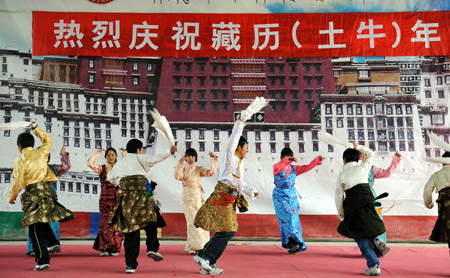Together with his wife, Padma Chosphel, a Tibetan farmer from Lhunze, southern Tibet, rose before his neighbors at 5 a.m. Wednesday and took his plastic bucket to a nearby river to fetch water.
Wednesday was the first day of the "earth ox" year on the Tibetan calendar.

Students of Tibetan ethnic group perform in celebration of the Tibetan New Year at Tibetan School in Jinan, capital of east China's Shandong Province, Feb. 25, 2009. Tibetans across China are celebrating the 50th Tibetan New Year after the Democratic Reform with their old traditions, photo from Xinhua.
In accordance with tradition, the first bucket of water obtained in the New Year is the purest and whoever has fetched it will be blessed with good luck all the year round.
Later Padma Chosphel fetched two more buckets of water at moments that coincided with dawn and sighting of the sun.
"It is our way to celebrate the start of the New Year and this practice is carried on year after year," he said.
In addition to fetching water, Padma and his family also ate a breakfast of a kind of congee made of qingke, a highland barley. The congee had other ingredients, such as brown sugar, and zanba, roasted qingke barley flour, a staple for Tibetans, alongside the head of a sheep -- an auspicious symbol.
"We actually began the preparation for the New Year festival Monday after we went through a ceremony that required a lit torch being used for dispelling evil or bad luck from the house, and ate gutu, steamed stuffed buns," said Padma.
While Padma used zanba to draw pictures on the walls the next day, his wife prepared qiema, a rectangle container holding zanba, qingke barley and qingke barley flour, which symbolizes a good harvest.
"We will go door to door extending New Year greetings around the village Thursday, the second day of the New Year, and will then sing and dance to greet the New Year," said Padma.
Sonam Dochen, a Tibetan woman from the same village, said her family spent about 2,000 yuan (294 U.S. dollars) shopping for the festival, buying new clothes for all the family.
Bumchok, who lives with her family in downtown Lhasa, capital of Tibet Autonomous Region, began the New Year with style.
Members of her family, clad in festive costumes, climbed on to the rooftop of her house early Wednesday and changed the sutra streamer.
"We chose to change the sutra streamer on the first day of the Tibetan New Year because this day is auspicious," she said. "After this, we will start to greet relatives and friends, or visit relatives."
Tsewang Sangpo, whose family live near Zhaibung Monastery in the suburbs of Lhasa, said, "To me, this New Year is full of good luck as several days back, my second child was born."
His family also followed the tradition and changed the sutra streamer early Wednesday.
To celebrate the Tibetan New Year, all ethnic Tibetans in China are entitled to a weeklong holiday that started Monday.
In Lhasa, the authorities organized fireworks displays at four downtown locations Monday night.
In the Tibet Autonomous Prefecture of Diqing, Yunnan Province, Ngawang Drakpa, a living Buddha from Shangri-la, said the New Year festival would mean a busy schedule of holy scripture recitals.
"Our monastery will host mass Buddhist services during the New Year holiday, and religious activities will continue until the 15th day of the first month," he said. "But lamas will make up by being allowed to have several days off from the 16th day, relaxing and having some fun."
Lhapa Keldon, 38, a member of the board for an expedition travel agency, spent many years in India during his childhood. He returned to Diqing at the age of 16.
"I felt completely different celebrating the Tibetan New Year in our hometown," said Lhapa, who believed celebration of the New Year was also a good occasion to promote Tibetan culture and tradition.
Lhapa had three goals for the New Year: recruiting 20 more members for his association, which aims to carry on and protect ethnic Tibetan culture, extend his hotel chain to three places including one hotel in Lhasa, and more overseas tours.
